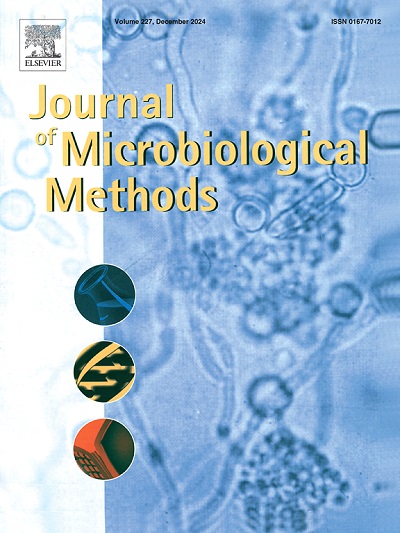直接从阳性血液培养物进行表型抗菌药物敏感性快速检测系统与磁盘扩散法和 VITEK 2 方法的比较研究。
IF 1.9
4区 生物学
Q4 BIOCHEMICAL RESEARCH METHODS
引用次数: 0
摘要
背景:败血症是一种危及生命的疾病,每年影响全球 4,900 万人,并导致 1,100 万人死亡。目的:评估 Quantamatrix 的 dRAST v2.5 系统(韩国首尔)与磁盘扩散 (DD) 和 VITEK 2 方法相比,直接从阳性血培养物中检测抗菌药物敏感性的性能:研究包括 191 份来自临床样本和加标血培养瓶的阳性血培养物。结果:dRAST 对革兰氏阴性分离物的 AST 性能非常好,对革兰氏阳性分离物的 AST 性能也很好,符合 CLSI 的新方法验收标准。与 VITEK 2 和 DD 相比,未被认为经过验证的抗菌药物有:针对革兰氏阴性菌的头孢唑啉、头孢他啶、美罗培南和三甲双胍/磺胺甲噁唑,以及针对革兰氏阳性菌的克林霉素、红霉素、青霉素和氧青霉素。结论:dRAST 显示出良好的 AST 性能,符合 CLSI 关于大多数相关抗生素的标准。dRAST 显著缩短了检测时间,减少了人力,降低了结果分析的主观性,使其成为支持菌血症患者治疗工作的重要补充。AST(抗菌药物药敏试验)、血液培养、dRAST、快速方法、败血症、周转时间(TAT)。本文章由计算机程序翻译,如有差异,请以英文原文为准。
A comparative study of a rapid phenotypic antimicrobial susceptibility testing system directly from positive blood cultures to the disk diffusion and VITEK 2 methods
Background
Sepsis is a life-threatening condition that impacts 49 million people annually and causes 11 million deaths worldwide. Surviving bloodstream infections (BSIs) depends on the rapid administration of effective antimicrobial treatment, underscoring a need for rapid antimicrobial susceptibility testing (AST).
Aim
To evaluate the performance of Quantamatrix's dRAST v2.5 system (Seoul, South Korea) for AST directly from positive blood cultures as compared to the Disk-Diffusion (DD) and VITEK 2 methods.
Methods
The study included 191 positive blood cultures from clinical samples and spiked blood culture bottles. Following Gram staining and species-level identification, AST was performed by VITEK 2 and standard DD methods using CLSI (2021) interpretation.
Results
dRAST demonstrated very good AST performance for a Gram-negative isolate, and good performance for Gram-positive isolates, meeting CLSI criteria for the acceptance of a new method. Antimicrobials that were not considered verified compared to VITEK 2 and DD were cefazolin, ceftazidime, meropenem, and trimethoprim/sulfamethoxazole for Gram-negatives and clindamycin, erythromycin, penicillin, and oxacillin for Gram-positives. dRAST ESBL detection results were strongly correlated with the ESBL phenotypes obtained with other methods. Additional resistance mechanisms were in concordance with traditional tests.
Conclusions
dRAST demonstrated good AST performance, meeting CLSI criteria for most relevant antibiotics. dRAST was associated with a significant reduction in time-to-results, labor, and the subjectivity of result analyses, making it a valuable addition to efforts supporting the treatment of patients with bacteremia.
AST (antimicrobial susceptibility test), blood culture, dRAST, rapid methods, sepsis, turnaround time (TAT).
求助全文
通过发布文献求助,成功后即可免费获取论文全文。
去求助
来源期刊

Journal of microbiological methods
生物-生化研究方法
CiteScore
4.30
自引率
4.50%
发文量
151
审稿时长
29 days
期刊介绍:
The Journal of Microbiological Methods publishes scholarly and original articles, notes and review articles. These articles must include novel and/or state-of-the-art methods, or significant improvements to existing methods. Novel and innovative applications of current methods that are validated and useful will also be published. JMM strives for scholarship, innovation and excellence. This demands scientific rigour, the best available methods and technologies, correctly replicated experiments/tests, the inclusion of proper controls, calibrations, and the correct statistical analysis. The presentation of the data must support the interpretation of the method/approach.
All aspects of microbiology are covered, except virology. These include agricultural microbiology, applied and environmental microbiology, bioassays, bioinformatics, biotechnology, biochemical microbiology, clinical microbiology, diagnostics, food monitoring and quality control microbiology, microbial genetics and genomics, geomicrobiology, microbiome methods regardless of habitat, high through-put sequencing methods and analysis, microbial pathogenesis and host responses, metabolomics, metagenomics, metaproteomics, microbial ecology and diversity, microbial physiology, microbial ultra-structure, microscopic and imaging methods, molecular microbiology, mycology, novel mathematical microbiology and modelling, parasitology, plant-microbe interactions, protein markers/profiles, proteomics, pyrosequencing, public health microbiology, radioisotopes applied to microbiology, robotics applied to microbiological methods,rumen microbiology, microbiological methods for space missions and extreme environments, sampling methods and samplers, soil and sediment microbiology, transcriptomics, veterinary microbiology, sero-diagnostics and typing/identification.
 求助内容:
求助内容: 应助结果提醒方式:
应助结果提醒方式:


